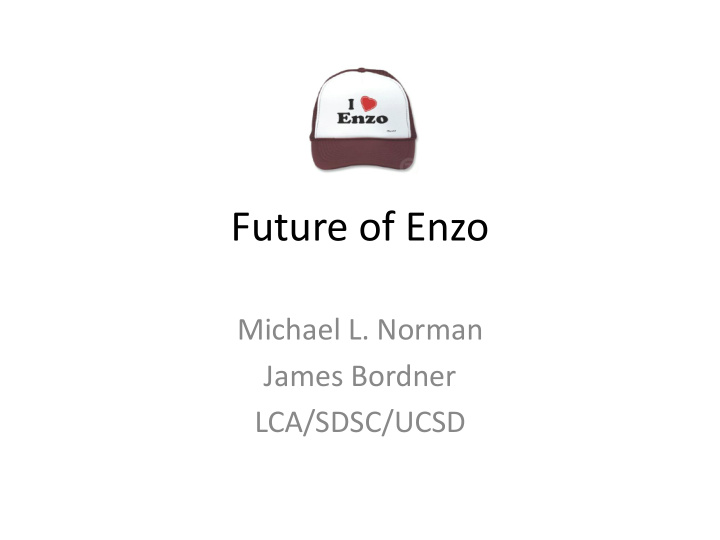



Future of Enzo Michael L. Norman James Bordner LCA/SDSC/UCSD
SDSC Resources “Data to Discovery” • Host SDNAP – San Diego network access point for multiple 10 Gbs WANs – ESNet, NSF TeraGrid, CENIC, Internet2, StarTap • 19,000 Sq-ft, 13 MW green data center • Host UC-wide co-location facility – 225 racks available for your IT gear here – can be integrated with SDSC resources • Host dozens of 24x7x365 “data resources” – e.g., Protein Data Bank (PDB) , Red Cross Safe and Well, Encyclopedia of Life,…..
SDSC Resources • Data Oasis: high performance disk storage – 0.3 PB (2010), 2 PB (2011), 4 PB (2012), 6 PB (2013) – PFS, NFS, disk-based archive • Up to 3.84 Tbs machine room connectivity • Various HPC systems – Triton (30 TF) Aug. 2009 UCSD/UC resource – Thresher (25 TF) Feb 2010 UCOP pilot – Dash (5 TF) April 2010 NSF resource – Trestles (100 TF) Jan 2011 NSF resource – Gordon (260 TF) Oct 2011 NSF resource
Data Oasis: The Heart of SDSC’s Data – Intensive Strategy Gordon – HPC System N x 10Gbe Trestles DataOasis Storage Triton – Petadata Analysis Dash OptIPortal Digital Data Collections Campus Lab Cluster Tile Display Wall SAN DIEGO SUPERCOMPUTER CENTER at the UNIVERSITY OF CALIFORNIA; SAN DIEGO
Trestles New NSF TeraGrid resource in production Jan 1, 2011 Aggregate specs 10,368 cores 100 TF 20 TB RAM 150 TB DISK 2 PB Architecture 324 AMD Magny-Cour nodes 32 cores/node 64 GB/node QDR IB fat tree interconnect SAN DIEGO SUPERCOMPUTER CENTER at the UNIVERSITY OF CALIFORNIA; SAN DIEGO
The Era of Data-Intensive Supercomputing Begins Michael L. Norman Allan Snavely Principal Investigator Co-Principal Investigator Interim Director, SDSC Project Scientist SAN DIEGO SUPERCOMPUTER CENTER at the UNIVERSITY OF CALIFORNIA; SAN DIEGO
The Memory Hierarchy of a Typical HPC Cluster Shared memory programming Message passing programming Latency Gap Disk I/O SAN DIEGO SUPERCOMPUTER CENTER at the UNIVERSITY OF CALIFORNIA; SAN DIEGO
The Memory Hierarchy of Gordon Shared memory programming Disk I/O SAN DIEGO SUPERCOMPUTER CENTER at the UNIVERSITY OF CALIFORNIA; SAN DIEGO
Gordon First Data-Intensive HPC system In production Fall 2011 Aggregate specs 16,384 cores 250 TF 64 TB RAM 256 TB SSD (35M IOPS) 4 PB DISK (>100 GB/sec) Architecture 1024 Intel SandyBridge nodes 16 cores/node 64 GB/node Virtual shared memory supernodes QDR IB 3D torus interconnect SAN DIEGO SUPERCOMPUTER CENTER at the UNIVERSITY OF CALIFORNIA; SAN DIEGO
SAN DIEGO SUPERCOMPUTER CENTER at the UNIVERSITY OF CALIFORNIA; SAN DIEGO
Enzo Science SMBH accretion First Stars Cluster radio cavities First Galaxies Lyman alpha forest Star formation Supersonic turbulence SAN DIEGO SUPERCOMPUTER CENTER at the UNIVERSITY OF CALIFORNIA; SAN DIEGO
History of Enzo collaborative sharing and development initial development LCA public releases OS public releases (Greg Bryan) inception AMR AMR-MPI Enzo 1.0 Enzo 1.5 Enzo 2.0 Enzo 2.x 1994 1996 1998 2000 2002 2004 2006 2008 2010 2012 2014 SAN DIEGO SUPERCOMPUTER CENTER at the UNIVERSITY OF CALIFORNIA; SAN DIEGO
Enzo V2.0 Pop III Reionization Wise et al.
Current capabilities: AMR vs treecode First galaxies (ENZO) Dark matter substructure (PKDGRAV2)
• ENZO’s AMR infrastructure limits scalability to O(10 4 ) cores • We are developing a new, extremely scalable AMR infrastructure called Cello – http://lca.ucsd.edu/projects/cello • ENZO-P will be implemented on top of Cello to scale to 10 6-8 cores
• Core ideas – Take the best fast N-body data structure (hashed KD-tree) and “condition” it for higher order -accurate fluid solvers – Flexible, dynamic mapping of hierarchical tree data structure to the hierarchical parallel architecture • Object oriented design – Build on best available parallel middleware for fault- tolerant, dynamically scheduled concurrent objects (Charm++) – Easy ports to MPI, UPC, OpenMP , …..
200K cores
Cello Status • Software design completed – 200 pages of design documents • ~20,000 lines of code implemented • PPM hydro code for uniform grid with Charm++ parallel objects initial prototype • Next up: AMR • Seeking funding and potential users
Recommend
More recommend